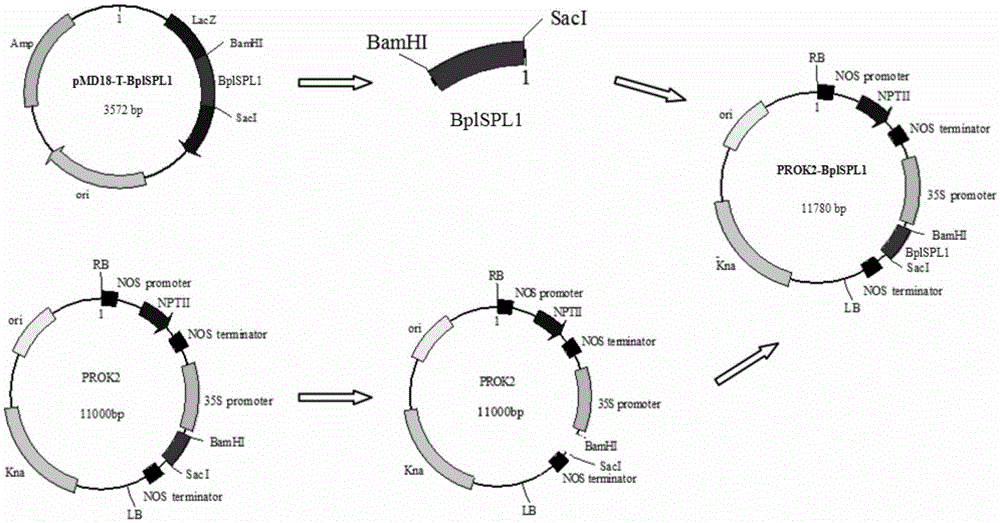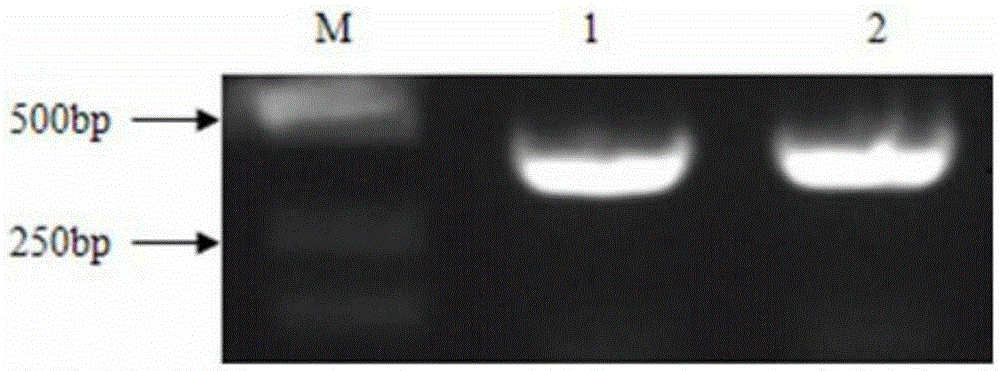Betula platyphylla BplSPL1 gene for promoting precocious flowering and encoded protein thereof
A technology for early flowering and encoding protein, applied in the field of birch BplSPL1 gene and its encoded protein, can solve the problems of unclear SPL gene function, no involvement of birch SPL1 gene sequence and its function, etc., so as to improve plant photoperiod and reduce flowering time. Effect
- Summary
- Abstract
- Description
- Claims
- Application Information
AI Technical Summary
Problems solved by technology
Method used
Image
Examples
Embodiment 1
[0027] Example 1: Cloning of Betula BplSPL1 Gene
[0028] (1) Acquisition of plant material
[0029] The experimental material Birch male flowers were collected from the birch forest of Northeast Forestry University. Immediately after collection, refrigerate to -80°C refrigerator for future use.
[0030] (2) Extraction of birch RNA
[0031] Birch total RNA was performed using the improved CTAB method, and the purity and concentration of total RNA were measured using agarose gel electrophoresis and ultraviolet spectrophotometer. Use QuantScript RT Kit to synthesize the first strand of cDNA, and then use BplSPL1-F and BplSPL1-R for PCR amplification. PCR reaction system: cDNA template 1μl, 10×Buffer 2μl, dNTP (2mM) 2.5μl, forward and reverse primers 1μl each (10μM), KOD-plus-Neo 1μl, MgSO4 (25mM) 1.5μl sterilized distilled water to make up 20μl. PCR amplification conditions were: pre-denaturation at 94°C for 2 min; denaturation at 94°C for 30 sec, annealing at 62°C for 1 min...
Embodiment 2
[0036] Embodiment 2: The plant expression vector construction of BplSPL1 gene
[0037] (1) Double enzyme digestion and detection of BplSPL1
[0038] The plant expression vector double digestion steps are as follows:
[0039] Both the cloning vector pMD18T-BplSPL and the plant binary vector pROK2 were digested with SacⅠ and BamHI. The digestion system was as follows: DNA 1 μg, 10×FD buffer 2 μl, SacⅠ 0.5 μl, BamHI 0.5 μl, and sterilized distilled water to make up 20 μl. After mixing, incubate at 37°C for 2-3h, and at 65°C for 5min. The double digested product was subjected to 0.8% agarose gel electrophoresis, and the target fragment was recovered according to the steps of the OMEGA recovery kit.
[0040] (2) Ligation of double enzyme digestion products
[0041] Ligate at 16°C overnight, and the ligation system is as follows: 4 μl of target gene, 2 μl of pROK2 vector fragment, 1 μl of T4 ligase, 2 μl of T4 buffer, and 20 μl of sterilized distilled water
[0042] (4) Transforma...
Embodiment 3
[0044] Example 3: Functional Analysis of BplSPL1 Gene Overexpression in Arabidopsis Plants
[0045] (1) Experimental materials: Peat soil and vermiculite were mixed evenly at a ratio of 1:1, and packed in plastic pots with a caliber of 8 cm. Pour water into the tray, and after the mixed soil fully absorbs water, sow several wild-type Colombian ecotype Arabidopsis seeds, cover with a layer of film, and pierce 2 to 3 small holes in the film on the top of each pot. 22 ℃, 16h light, 8h dark culture. After the seeds germinate, remove the film and thin the seedlings, leaving 2 to 3 Arabidopsis plants in each pot.
[0046] (2) Agrobacterium-mediated pollen infecting Arabidopsis
[0047] 1) Preparation of bacterial solution: Dip the bacterial solution with an inoculation loop and streak on the LB medium added with rifampicin and kanamycin (concentrations of 10 μg / mL and 50 μg / mL, respectively) to cultivate a single colony. Pick a single colony and inoculate it in an Erlenmeyer flas...
PUM
 Login to View More
Login to View More Abstract
Description
Claims
Application Information
 Login to View More
Login to View More - R&D
- Intellectual Property
- Life Sciences
- Materials
- Tech Scout
- Unparalleled Data Quality
- Higher Quality Content
- 60% Fewer Hallucinations
Browse by: Latest US Patents, China's latest patents, Technical Efficacy Thesaurus, Application Domain, Technology Topic, Popular Technical Reports.
© 2025 PatSnap. All rights reserved.Legal|Privacy policy|Modern Slavery Act Transparency Statement|Sitemap|About US| Contact US: help@patsnap.com



